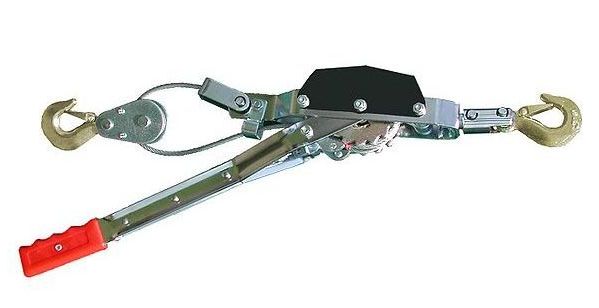Come-a-Longs (Download)
Come-a-longs 1 Definition Small portable winch usually consisting of a cable attached to a hand-operated ratchet http://www.merriam-webster.com/dictionary/come+along?show=1&t=1302724539 2 Definition May also be referred to as: Ratchet Hoist Red-Devil Guy Puller Pull Jacks http://www.msha.gov/Accident_Prevention/Tips/ratchethoist.htm 3 History Developed by Abraham Maasdam Developed in 1919 Commercialized by Felber Maasdam Commercialized in 1946 http://en.wikipedia.org/wiki/Hoist_(device) 4 Applications Come-a-longs can be used for: Fence stretching Moving machinery Moving pipe or plates into position for welding or bolting Stretching cable (power lines, telephone lines,etc) http://www.empirepac.com/downloads/toolboxTalks/Come%20Alongs%20and%20Hoists2.pdf 5 Applications http://my5acredream.blogspot.com/2010/10/progress-on-fence.html Figure: Section of fence being stretched into place using a come-a-long 6 Injuries Most common injuries occur when the hook slips or something in the “system” fails. http://www.msha.gov/Accident_Prevention/Tips/ratchethoist.htm Figure: Worker securing power line into position 7 Injuries Some injuries that can occur include: Deep gashes Lost teeth Concussions Fracturing of the hands, arms, legs and ribs Electrocution Falls http://www.msha.gov/Accident_Prevention/Tips/ratchethoist.htm 8 Accidents Accidents occur: When the hook slips When something in the ‘system’ fails Failures often cause the chain, rope, or wire to ‘whip’ back with considerable force http://www.msha.gov/Accident_Prevention/Tips/ratchethoist.htm 9 Stats (not specific to construction) From 1992 to 2004, 136 workers died in the United States from overhead hoist operations. Nine fatalities occurred in 2004, with an additional three deaths in 2003. Come-a-longs account for about 1 in 10 hand tool accidents. http://www.msha.gov/Accident_Prevention/Tips/ratchethoist.htm http://www.anapolschwartz.com/practices/construction-accidents/dangerous-hoists.asp 10 Construction Fatalities In the time period of 1990 thru 2009 there were 16 fatalities investigated by OSHA. http://www.krallconst.com/Electrical.html Source: Extracted from OSHA Accident Investigation Data 11 Come-a-Long Fatality Case Workers were attaching a cable to a utility pole using a come-a-long when the energized conductor fell from its base and electrocuted the worker in the bucket truck Source: Extracted from OSHA Accident Investigation Data 1990-2009 12 Come-a-Long Fatality Case A worker had a come-a-long attached to a step bolt above an antenna mount. When the step bolt broke, the worker fell 170 feet to the ground. Source: Extracted from OSHA Accident Investigation Data 13 OSHA Provision 1926 Appendix A, Subpart L (2)(r)(3) When using Catenary Scaffolds, the maximum capacity of come-along shall be 2,000 lbs. 14 PPE for Safety Safety glasses Gloves Hard hat Steel-toed boots 15 Best Practices In addition to OSHA regulations, there are some ‘best practices’ to prevent injury. Figure: Worker securing power line into position 16 Best Practices Make sure that latches work properly and are in good condition. Check the cable, chain or strap for any type of damage (fraying or splitting). Tag defective items and remove them from service. http://www.msha.gov/Accident_Prevention/Tips/ratchethoist.htm 17 Best Practices Be certain that all parts of the ‘system’ can take the load. Do not forget to check anchor points. Use appropriate anchors or slings. Do not use a CHEATER BAR (an extended handle) to exert more force on the come-a-long than it is designed for. http://www.msha.gov/Accident_Prevention/Tips/ratchethoist.htm 18 Best Practices Keep safe load limit posted on the hoist. Keep wire ropes and chains lubricated. http://www.anapolschwartz.com/practices/construction-accidents/dangerous-hoists.asp 19 Best Practices Do not leave suspended loads unattended. Do not use as blocking for raised equipment. http://www.anapolschwartz.com/practices/construction-accidents/dangerous-hoists.asp Figure: Come-a-long being used to hold up and stabilize a mixing motor 20 Best Practices Do not use for lifting people. Do not pass a load over workers. Do not insert the point of the hook in a link. Do not exceed the rated load capacity. Do not straddle come-along Keep the body out of the line of fire http://www.anapolschwartz.com/practices/construction-accidents/dangerous-hoists.asp Figure: Employee securing electrical cable using come-a-long 21 Think Safety Work Safely 22

